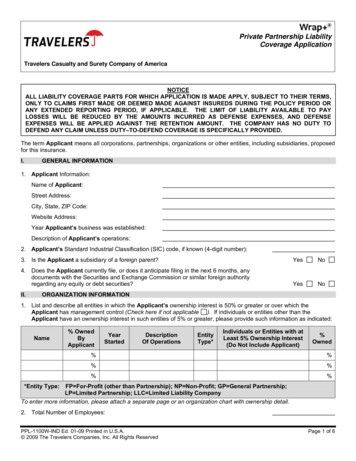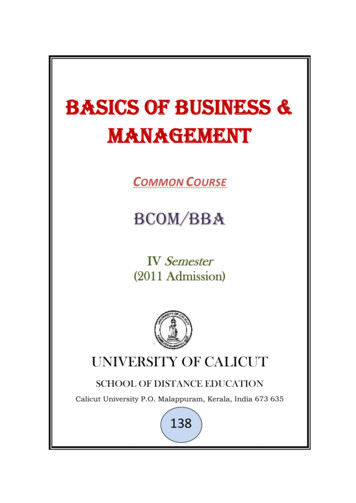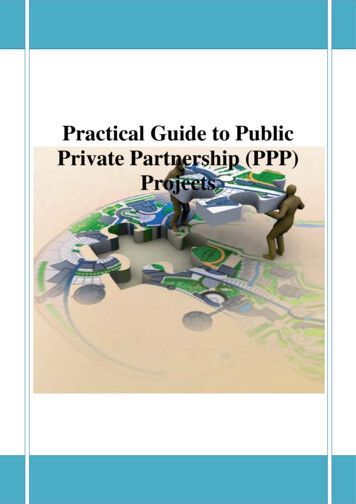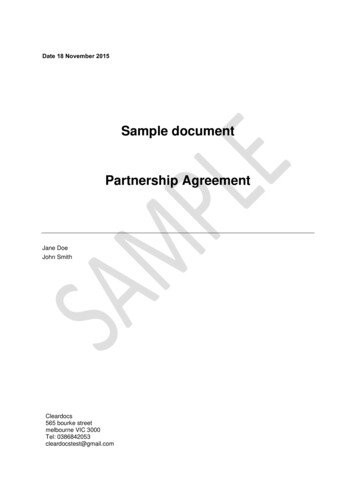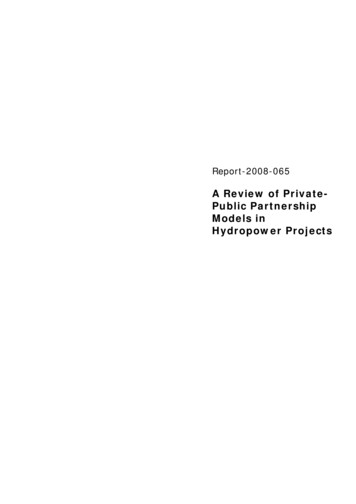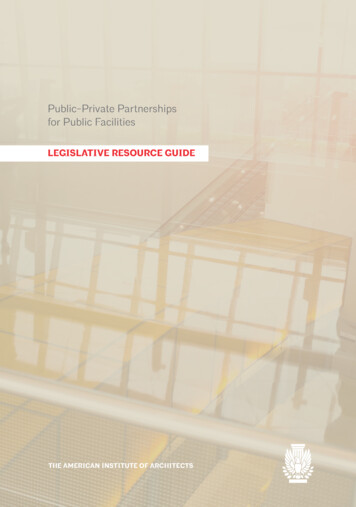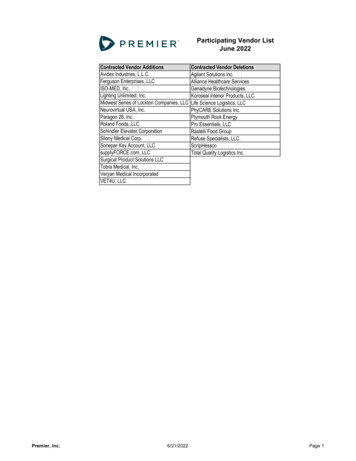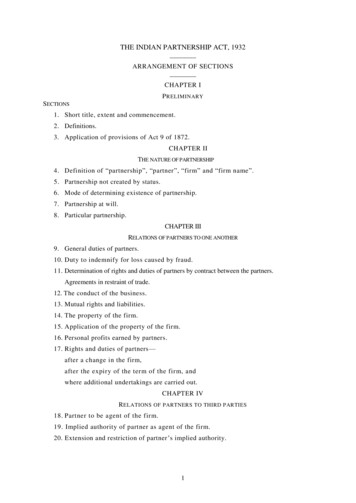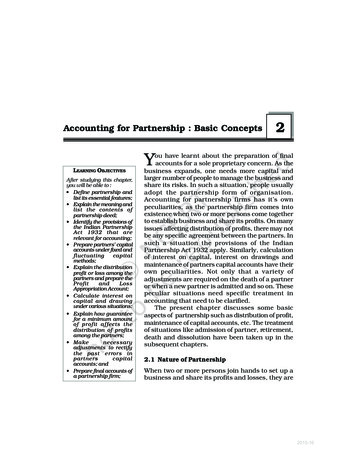
Transcription
Government of IndiaMinistry of FinanceDepartment of Economic AffairsPublic Private PartnershipProjects in IndiaCompendium of Case Studiesc
Government of IndiaMinistry of FinanceDepartment of Economic AffairsPublic Private PartnershipProjects in IndiaCompendium of Case StudiesDecember 2010
Public Private Partnership projects in IndiaCompendium of Case Studies Department of Economic AffairsAll rights reservedPublished by:PPP Cell, Department of Economic AffairsMinistry of Finance, Government of IndiaNew Delhi-110 001, Indiawww.pppinindia.comDisclaimerThis Compendium of Case Studies has been prepared as a part of a PPP capacity buildingprogramme that is being developed by the Department of Economic Affairs, Ministry of Finance,Government of India (DEA) with funding support from the World Bank, AusAID South Asia RegionInfrastructure for Growth Initiative and the Public Private Infrastructure Advisory Facility (PPIAF).A consulting consortium, consisting of Economic Consulting Associates Limited (ECA) and CRISILRisk and Infrastructure Solutions Limited (CRIS), commissioned by the World Bank, has preparedthis compendium based on extensive external consultations.ECA and CRIS have taken due care and caution in preparing the contents of this compendium. Theaccuracy, adequacy or completeness of any information contained in this toolkit is not guaranteedand DEA,World Bank, AusAID, PPIAF, ECA or CRIS are not responsible for any errors or omissions,or for the results obtained from the use of such information. The contents of this compendiumshould not be construed to be the opinion of the DEA, World Bank, AusAID or PPIAF. DEA is notliable for any direct, indirect, incidental or consequential damages of any kind whatsoever to thesubscribers / users / transmitters / distributors of this toolkit.The compendium shall not be reproduced in any form, other than those intended by DEA, withoutprior written permission from DEA.
Contents1Overview12.Snapshot Of Case Studies23.Key Learnings54.Case Study 1:Alandur Sewerage Project155.Case Study 2:Karnataka Urban Water Supply Improvement Project276.Case Study 3:Latur Water Supply Project387.Case Study 4:Salt Lake Water Supply And Sewerage Network508.Case Study 5:Timarpur Okhla Integrated Municipal Solid Waste Management Project589.Case Study 6:Vadodara Halol Toll Road6810. Case Study 7:Tuni Anakapalli Annuity Road Project7611. Case Study 8:Delhi Gurgaon Expressway8212. Case Study 9:Nhava Sheva International Container Terminal9013. Case Study 10:Kakinada Deep Water Port9814. Case Study 11:Gangavaram Port10515. Case Study 12:Mumbai Metro11216. Case Study 13:Hyderabad Metro12117. Case Study 14:Bhiwandi Electricity Distribution Franchisee13018. Case Study 15:Amritsar Intercity Bus Terminal Project13919. Abbreviations and Acronyms148iii
Public Private Partnership projects in IndiaCompendium of Case Studies
OneOverviewThis compendium presents case studies of fifteen select Public-Private-Partnership (PPP) projectsin India. The case studies have been prepared to highlight the experience and lessons learnt so farand thereby influence the design of future PPP processes and structures to improve the quality ofPPP projects.The choice of case studies provides a representation across different sectors, covers different PPPproject structures, includes projects at different stages of the PPP life-cycle and has projects withdifferent levels of complexity.These case studies include the following:a.A description of the project with project features;b.The project structure adopted with details of the roles and responsibilities of the privateand public partners;c.The financing details of the project along with the current statusd.A description of the PPP process adopted including project identification, project feasibility,structuring of the contract/concession and awarding projects to private partners. Thisincludes details like the timing of major events like tendering and details like the level ofresponse to the bid process;e.A detailed matrix of initial allocation of key risks across the public and private sectorpartners, along with details of subsequent changes, if any, and an assessment of theimplications of the risk allocation;f.A concise assessment of the achievement of objectives originally set out for the project,viz., improvements in service delivery - e.g., capacity, quality, coverage affordability - withindicative parameters, to the extent possible;g.A Value For Money (VFM) assessment of the project to illustrate the benefits of followinga PPP approach vis-à-vis the alternative of public procurement; andh.A summary of the key learning and observations from the project.It is expected that the case studies will assist the public authorities in:Understanding the needs, challenges and risks associated with alternate PPP arrangementsin specific sector.Improving quality of project identification, preparation, award and monitoring of PPPs andassociated issues such as, for example, governance and fiscal implications.Managing the transition to a large scale PPP program to improve infrastructure services.1
Public Private Partnership projects in IndiaCompendium of Case StudiesTwoSnapshot of Case StudiesThe following table provides a snapshot of the fifteen case studies.SectorPpp projectstructureState andyear pppcontractsignedGovernment /public sectorentity / entitiesPrivate sectorpromoter/ sponsor /consortiummembersProjectcostConcessionperiod 34.6 crore(SewerageNetwork)O&M Contract– 5 years1. Alandur Underground Sewerage age System)Tamil Nadu2000O&M Contract(UndergroundSewerage System)AlandurMunicipality and theTamil Nadu UrbanInfrastructureFinancial ServicesLimited (TNUIFSL)IVRCLInfrastructures andProjects Ltd andVa Tech WabagTechnologies Ltd.Build-OperateTransfer (BOT)Annuity (SewageTreatment Plant) 6.68 crore(SewageTreatmentPlant)BOT Annuity –14 years2. Karnataka Urban Water Supply ImprovementUrban WaterSupplyOperations &ManagementContractVeolia Water 32 crore(formerly known asCompagnie Generaledes Eaux, France)Karnataka2005Karnataka UrbanInfrastructureDevelopmentand raSubhash Projects &Jeevan Pradhikaran Marketing Limited,UPL EnvironmentalEngineers Limitedand Hydro CompEnterprises IndiaPrivate Limited.42 months(Laterextended to 59months)3. Latur Water Supply ProjectWater SupplyOperations &ManagementContract 182 crore(includingpaymentto MJP forright to useassets)10 years4. Salt Lake Water Supply and Sewage Disposal SystemWater &SewageBOT(includes Designand Finance)West Bengal2007KolkataMetropolitanDevelopmentAuthority andNaba DigantaIndustrialTownshipAuthorityJamshedpur Utilitiesand ServicesCompany Limitedand Voltas Limited 70.09 crore 30 years5.Timarpur Okhla Integrated Municipal Solid Waste Management ProjectUrbanInfrastructure- MunicipalSolid Waste2BOOT (includesDelhiDesign and Finance) 2008New DelhiMunicipalCorporation(NDMC) andMunicipalCorporation ofDelhi (MCD)Jindal UrbanInfrastructureLimited 200 crore25 years
SectorPpp projectstructureState andyear pppcontractsignedGovernment /public sectorentity / entitiesPrivate sectorpromoter/ sponsor nment ofGujaratGovernment ofGujarat and IL&FS 161 crore30 years6.Vadodara Halol Toll RoadRoadsBOOT) (includesGujaratDesign and Finance) 19987.Tuni Anakapalli Annuity Road ProjectRoadsBOT Annuity(includes Designand Finance)AndhraPradesh2001National Highways GMR Group, UnitedAuthority of India Engineers Malaysia(UEM) BerhadGroup 315 croreDelhi andHaryana2002National Highways DS ConstructionsAuthority of India and JaiprakashIndustries 1,175crore8. Delhi Gurgaon ExpresswayRoads –ExpresswaysBOT(includes Designand Finance)20 years9. Nhava Sheva International Container TerminalPorts (Major)BOT (includesMaharashtraDesign and Finance) 1997Jawaharlal NehruPort TrustP&O Australia 733 crorePorts Pty Limited,KonsortiumPerkapalan Berhadand Trans ImpexPrivate Limited (P&OPorts subsequentlytaken over by DubaiPorts World Limited(DP World))Government ofAndhra PradeshLarsen & Toubro Ltd,India, StevedoringServices of America,USA, PreciousShipping Company,Thailand, KonsortiumPerkaplan Berhard,Malaysia30 years10. Kakinada Deep Water PortPorts (Minor)BOT(includes sharing ofrevenue with Govt)AndhraPradesh1999 330 crore(4th Berthincludingoffshorejetty)20 years(extendable byl 2 periods of 5years each)Later extendedto 30 years(extendable by2 periods of 10years each)11. Gangavaram PortPorts (Minor)BOOT (includesAndhraDesign and Finance) Pradesh2004Government ofAndhra PradeshMr. D.V.S. Raju & 1,696associates, WarburgcrorePincus and theAndhra PradeshInfrastructureInvestment uthority(MMRDA)Reliance EnergyLimited,VeoliaTransport (France)and MMRDA 2,356crore35 yearsGovernment ofAndhra PradeshMaytasInfrastructure,Government ofAndhra Pradesh,Nav Bharat Ventures,IL&FS and Ital-Thai(Subsequentlycancelled in 2009) 11,814crore35 years30 years(extendableby additional 2periods of 10years each)12. Mumbai MetroUrbanInfrastructure– Mass RapidTransportBOOT (includesMaharashtraDesign and Finance) 200713. Hyderabad MetroUrbanInfrastructure– Mass RapidTransportBOT(includes Designand Finance)AndhraPradesh2008(Subsequentlycancelled in2009)3
Public Private Partnership projects in IndiaCompendium of Case Studies4SectorPpp projectstructureState andyear pppcontractsignedGovernment /public sectorentity / entitiesPrivate sectorpromoter/ sponsor ashtraState ElectricityDistributionCompany LimitedTorrent Power AECLimited (TPAL) 61 crore(MSEDCL)10 yearsDepartment ofTransportation(DoT),Government ofPunjabRohan Builders(India) Pvt Ltd.,Rajdeep BuildconPvt Ltd and RajdeepRoad DevelopersPvt. Ltd.14. Bhiwandi Electricity Distribution FranchiseeElectricityDistributionOperations &ManagementContract(Franchisee)Maharashtra2004 250 crore(TPAL)15. Amritsar Inter-city Bus TerminalUrbanTransportBOT(includes Designand Finance)Punjab2004 21.34crore11 years 5months
ThreeKey LearningsThis section highlights the key learnings from India’s experience in PPPs as witnessed in the detailedcase studies of select infrastructure PPPs in India. The objective of these learnings is to identify thetypical issues that PPPs in India experience, how they may be dealt with and what mistakes couldbe avoided by PPP practitioners. They identify ways to mitigate various risks experienced by PPPprojects, thus improving the overall value for money for the government.This section may be read in conjunction with the detailed case studies for readers who may wantto study the context of each issue in greater detail.3.1 Summary of Learnings with referenced case examplesThe following table provides a summary of the learnings identifies and the case examples referredto.No.LearningKey risks addressedPpp examples to beemulatedPpp examples whereproblems wereencountered1. Delhi GurgaonExpresswayProject Preparation1Robust Traffic / MarketAssessmentsOperations Risk, Time &Cost Overruns Risk-2Comprehensive DueDiligence StudiesDesign Risk, ApprovalsRisk, Time and CostOverrun Risks, PolicyRisk, Revenue Risk1. Timarpur IntegratedSolid WasteManagement Project1. Vadodara Halol TollRoad3Clarity in Determinationof TariffsRevenue Risk,Termination Risk1. Latur Water SupplyProject1. Nhava Sheva IntegratedContainer TerminalRobust & Simple BidCriteriaDefault Risk, TerminationRisk-1. Gangavaram Port2Dealing with SpeculativeBidsDefault Risk, TerminationRisk1. Gangavaram Port1. Hyderabad Metro3Importance of LeadConsortium Member/ Promoter ofConcessionaireFinancing risk, Time andcost overruns risks-1. Hyderabad MetroLand acquisition risk,Time and Cost OverrunsRisks, Social Risk1. Hyderabad Metro1. Delhi GurgaonExpresswayApprovals risk, Time andcost Overruns risks1. Alandur SewerageProject2. Gangavaram PortProcurement12. Nhava Sheva IntegratedContainer TerminalDevelopment1Handling of Landacquisition2. Mumbai Metro3. Gangavaram Port2Streamlining of Approvals& Clearances1. Delhi GurgaonExpressway2. Karnataka Urban WaterSupply ImprovementProject3Well Defined ProjectScopeScope Change risk, Timeand cost Overruns risks-1. Delhi GurgaonExpressway5
Public Private Partnership projects in IndiaCompendium of Case StudiesNo.LearningKey risks addressedPpp examples to beemulatedPpp examples whereproblems wereencountered4Environmentally andSocially responsivedevelopment frameworkSocial Risk, EnvironmentRisk, Land acquisitionrisk, Social Risk, Time andcost Overruns risks1. Vadodara Halol TollRoad-Financing InnovationsFinancing Risk, DefaultRisk, Performance Risk1. Tuni Anakapalli Road52. Timarpur Solid wastemanagement project1. Hyderabad Metro2. Vadodara Halol TollRoad3. Alandur SewerageProjectOperations1Favourable OperatingEnvironmentPolicy Risk, Revenue Risk1. Amritsar Inter-citybus terminal1. Kakinada Deep WaterPort2. Latur Water Supplyproject23Need for Public supportStrong political willTime and Cost OverrunRisks, Social Risk,Revenue Risk , PoliticalRisk1. Alandur SewerageProjectPolitical Risk, Time andCost Overruns Risk ,Revenue Risk, Social Risk1. Alandur SewerageProject1. Latur Water SupplyProject2. Kakinada Deep WaterPort1. Latur Water SupplyProject2. Bhiwandi ElectricityDistribution Franchise3. Salt Lake WaterSupply project4Resolution of Issuesthrough MutualDiscussionsTermination risk1. Kakinada Deep Water Port3.2 Learnings across the PPP Process3.2.1 Project PreparationRobust Traffic / Market Assessmentsa.Realistic and robust traffic / market assessment studies are an important step in the projectpreparation stage for a PPP project. Such assessments ensure bids submitted by interestedprivate entities are well informed and realistic and the overall capacity proposed for a projectis optimum. They also ease the pressure during the operations phase since the operator is notexposed to very divergent demand and corresponding revenue risks. Examples of PPPswhere problems were encounteredIn the Delhi Gurgaon Expressway project, NHAI relied on an outdated traffic study. Thus,the actual traffic volume grossly outnumbered the projections from the very beginning ofcommercial operations. In fact as soon as the expressway was opened to traffic, the unexpectedhigh number of vehicles led to heavy queuing at the toll booths and delays in traversing thestretch.However, timely action and necessary measures by authorities and the Concessionaireimproved conditions.Key Risks Triggered: Operation RiskSimilarly, in the Gangavaram Port project, realistic traffic projections were not prepared thusleading to speculative bids. The government of Andhra Pradesh had to reject the bids andthe process was launched again. This could have been avoided if robust traffic projectionshad been prepared and shared with the bidders. The launch of the bid process delayed thecommencement of the port development.Key Risks Triggered:Time and Cost Overrun Risks6
Comprehensive Due Diligence StudiesThe environment in which a project will be developed and will have to operate has an importantbearing on the progress of PPPs. Due diligence studies – technical and legal are essential to ensurethe smooth progress of a project through the project life-cycle.a.Examples of PPPs to be emulatedThe Timarpur Integrated solid waste management project showcases how efforts were madeon project preparation prior to the launch of the bid process. Important steps such as detailedtechnical studies and reviews, financial evaluation, risk evaluation and obtaining regulatory aswell as statutory approvals was undertaken at the project preparation stage itself. In fact,the SPV to implement the project was also incorporated prior to the launch of the bid. Thisensured that the actual project development phase experienced as few hurdles as possible.Key Risks Managed Better: Design Risk, Approvals Risk,Time and Cost Overrun Risksb.Examples of PPPs where problems were encounteredThe Vadodara Halol Toll Road project highlights the fact that project due diligence needs tobe robust since it can impact the long term objectives of a project. In this case, the trafficestimations for the project were based on the assumption that the industrial incentivesavailable for the project area would continue over the long-term. However, the incentives wereeventually withdrawn and the traffic was almost 50% lower than the projected traffic.This lapsewith respect to the understanding of the legal environment in which the project had to operateand the resultant policy risk put undue pressure on the viability of the project operations.Key Risks Triggered: Policy Risk, Revenue RiskClarity in Determination of TariffThe tariff is a key determinant of returns for the private entity. It is important to have a clearunderstanding of the tariff determination process and the same should be fair to enable the privateoperator to earn a reasonable return. Lack of clarity can result in potential disputes between theprivate and public entity.a.Examples of PPPs to be emulatedIn the Latur Water Supply project, tariff for the contract duration was finalised prior to thebidding process, to allow the bidders to quantify the tangible benefits from undertaking theproject. The tariff structure was to see a staggered increase based on the contract terms. Thisreduced the revenue risk to an extent.Key Risks managed better: Revenue Riskb.Examples of PPPs where problems were encounteredIn the Nhava Sheva Integrated Container Terminal project, the lack of clarity in the concessionagreement on whether the royalty payment was to be considered as a part of cost or ashare in the profit in the SPV’s accounts while determining the port tariff, became a seriousissue between the public and the private sector. Measures were adopted to address theseinconsistencies but with limited success.Key Risks Triggered: Revenue Risk,Termination Risk3.2.2 ProcurementRobust and Simple Bid CriteriaBid evaluation criteria need to be simple and robust so that capable entities are identified forthe project and at the same time bids are not speculative. Speculative bids have the potential to7
Public Private Partnership projects in IndiaCompendium of Case Studiesderail a project during the operations stage if the private entity is unable to sustain its overstatedcommitments. Ambiguities in the bid criteria, on the other hand, can lead to disputes between theprivate and public entity during the operations stage.a.Examples of PPPs where problems were encounteredIn the Gangavaram port project, the first round of tendering had several evaluation parametersthat were working at cross purposes and encouraged speculative bidding. The bid criteriagave separate weights for the Minimum Guaranteed Amount, revenue share and investmentcommitments. Thus larger commitments, even though unrealistic, could have lead to higherscores. While the government eventually decided to terminate the process, this could haveresulted in an unsustainable project.Key Risks Triggered: Default Risk, Termination Risk (However since the bid process wasterminated, these risks did not actually get triggered – Refer Learning 2.2.2)In the Nhave Sheva Integrated Container Terminal, the bid evaluation criterion of the highestNPV of royalty payment was simple but insufficient. The lack of a methodology to assess theroyalty payout to the licensor and the problems arising from the interaction of the royalty withthe tariff level created a number of issues in the subsequent operations phase.Key Risks Triggered: Default Risk,Termination RiskDealing with Speculative Bidsa.While speculative bids should ideally be avoided, if encountered, the public entity should dealwith them without jeopardising the long term prospects of the project. This could even meanterminating and re-launching the bid process. Examples of PPPs to be emulatedIn the Gangavaram port project, the evaluation in the first round of bids revealed concernsregarding the validity and practicality of the market assumptions and the underlying viabilityof the projections. Both the bids had elements of speculation and presented an untenableproposition for the Government. This was due to the absence of a comprehensive feasibilitystudy with realistic traffic projections which should have been undertaken by the government.(Refer learning 2.1.1) However, the Government did not get attracted by the speculative bidsand decided to terminate the bid process.Key Risks Managed Better: Default Risk, Termination Riskb. Examples of PPPs where problems were encounteredIn the Hyderabad Metro project, the government provided commercial development rightsfor almost 296 acres of land allocated for the depots and the stations. This aggregated toa cumulative maximum of 18.5 million square feet and was a substantial percentage of theproject cost.This opportunity of the utilization of land on a commercial basis coupled with the metroproject led to widely divergent bids from the bidders. While the Siemens Consortium bida negative viability gap of 250 crore, the Maytas Consortium bid a very high a negativeviability gap of 30,311 crore. On the other hand, the two other bidders--Reliance sought aVGF grant of 2,811 crore from the government and Essar sought a grant of 3,100 crore.While the award of this project to Maytas was eventually withdrawn, such speculative bidsexposed the project to the risk of the actual construction and quality of the metro beingcompromised as the private operator would have had a greater incentive to complete the realestate development at the cost of the metro.Key Risks Triggered: Default Risk,Termination Risk8
Importance of Lead Consortium Member / Promoter of ConcessionaireThe concessionaire’s ability to undertake complex projects is typically a function of the experienceand expertise brought on board by their lead consortium member or promoter. Accordingly, it isessential that there is adequate due diligence of the promoter backing the concessionaire and thecontinued involvement of the lead member is contractually ensured, at least during the projectdevelopment stage.a.Examples of PPPs where problems were encounteredThe Hyderabad Metro project saw the winning consortium of Maytas Metro getting adverselyaffected due to the issues besetting its promoter – Satyam Computer Services. Although theproject was to be implemented by a separate Special Purpose Vehicle, there was a loss ofinvestor confidence in the promoters of the project and consequently, the project was not ableto achieve financial closure. The government finally had to withdraw its award and re-launchthe bid process.Key Risks Triggered: Financing risk, Time and cost overruns risks3.2.3 DevelopmentHandling of Land Acquisitiona.The land acquisition process for PPP projects is no doubt the most challenging predevelopment activity in India. In most cases, the government commits provision of land freefrom encumbrances for the project before actually completing the necessary formalities.Examples of PPPs to be emulatedWhile many readers may associate the bankruptcy of its promoters (Satyam) with the HyderabadMetro project, a lesser known fact is the commendable manner in which the government dealtwith land acquisition in the concession agreement. It required the government to handoverland to the concessionaire by the financial closure date. Further, 90% of the land had to behanded-over within 120 days from signing of the agreement. There were penalties built into the contract in case the government delayed the delivery of the land. Such contractualtreatment would have ensured greater planning and focussed efforts on land acquisition by thegovernment. Further to mitigate this risk, the project intended to use government lands for thedevelopments of depots and stations to the extent possible.Key Risks managed better: Land acquisition Risk,Time and Cost Overruns Risksb. Examples of PPPs where problems were encounteredIn the Delhi Gurgaon expressway project, the government committed to the promoters forproviding a substantial area of land, prior to actually acquiring the land. Due to the thicklypopulated surrounding areas of the expressway, there were certain pockets of land that weredifficult to acquire. This exposed the government to the risk of not providing the land withinreasonable time impacting the overall schedule of the project. It would have been better ifuncontrollable risks such as these were addressed before the project procurement stage itselfto ensure smooth functioning of the project. This could have been achieved by completing theland acquisition process prior to the project procurement process itself.Key Risks Triggered: Land acquisition risk,Time and Cost Overruns RisksSimilarly for the Mumbai Metro, the government committed that the land for the project wouldbe procured as per the land procurement schedule provided in the agreement. However, thisland was under private ownership and at times under dispute. This exposed the governmentto the risk of land not being available thereby resulting in inordinate delays in commencementof construction of the project. While this issue was eventually resolved, it would have beena better option for the government to have dealt with it prior to signing of the concessionagreement.9
Public Private Partnership projects in IndiaCompendium of Case StudiesKey Risks Triggered: Land acquisition risk,Time and Cost Overruns RisksThe Gangavaram port project was another case in point where the land acquisition processwas prolonged due to local protests in relation to rehabilitation and resettlement.Key Risks Triggered: Land acquisition risk,Time and Cost Overruns Risks, Social RiskStreamlining of Approvals & ClearancesApart from land acquisition, obtaining numerous clearances and approvals has been the baneof Indian PPP projects. Typically, the concessionaire needs to obtain clearances from multiplegovernment departments and apprise different departments about the progress of a project. Thesedelays add to the cost of developing the PPP and thereby reduce the value for money to the publicsector.Ideally a single interface for interactions or coordination on all such approvals should be setup bythe government to prevent undue delays. This could be in the form of a lead entity taking up theresponsibility or a common project steering/ empowered committee that is appointed to take careof all such formalities. With this, the concessionaire could focus on the core development issuesrather than being entangled in administrative processes.a. Examples of PPPs to be emulateThe Alandur Sewerage Project had a streamlined process for obtaining approvals and clearancesrelated to the project. The Alandur Municipality took up the responsibility for key approvals,including road cutting, shifting of services and environmental clearances. The developer wasresponsible only of the ‘works’ related approvals. This approach ensured there was minimumdelay in obtaining the necessary permits.Key Risks Managed Better: Approvals risk,Time and cost Overruns risksb. Examples of PPPs where problems were encounteredThe Delhi Gurgaon expressway project is a case in point where the approvals process resultedin significant delays for the concessionaire. Since the project was spread across the states ofDelhi and Haryana, there were more than fifteen government agencies/civic bodies affectedby the development of this highway that had to grant approvals for the project. This became acomplex and time consuming process during the construction period.Key Risks Triggered: Approvals risk,Time and cost Overruns risksOn similar lines, the Karnataka Urban Water Supply Improvement project, experienced delaysin obtaining permits from several departments due to the lack of co-ordination across thethree Urban Local Bodies involved in the project.Key Risks Triggered: Approvals risk,Time and cost Overruns risksWell Defined Scope of WorkIt is essential that the concessionaire’s scope of work is well defined, prior to the launch of thebid process and the same is not modified except in the case of unavoidable and unforeseencircumstances. Changes in scope of work, which typically result in time and cost overruns, have thepotential to derail PPP projects.a.Examples of PPPs where problems were encounteredThe Delhi Gurgaon expressway experienced significant time and cost overruns on account ofa change in the concessionaire’s scope of work. There were substantial changes in the originaldesign that were sought by NHAI and the government keeping in mind future requirements andthe convenience of commuters. While these should have been anticipated and incorporated10
prior to the launch of the bid process, the order for provisional change of scope was finalisedand issued to the concessionaire just days before the original scheduled completion date of theproject.Key Risks Triggered: Scope Change risk,Time and cost Overruns risksEnvironmentally and Socially responsive development frameworkInfrastructure projects typically have significant social and environmental impacts, arising from theirconstruction and operation. Social impacts are on the communities affected by the project andenvironmental impacts are on account of the project location.It is therefore necessary that PPPs have an environmentally and socially responsive developmentframework. While social and environment impact assessments are mandatory, there are fewexamples of how projects have proactively adopted best practices in this regard.An environmentally and socially responsive framework would in fact help garner public support fora PPP project more easily (Refer Learning 2.4.2) and have a positive impact on the land acquisitionprocess. (Refer Learning 2.3.1)a.Examples of PPPs to be emulatedThe Vadodara Halol Toll Road was the first project that introduced environmental andsocial safeguards measures as part of the c
Transfer (BOT) Annuity (Sewage Treatment Plant) Tamil Nadu 2000 Alandur Municipality and the Tamil Nadu Urban Infrastructure Financial Services Limited (TNUIFSL) IVRCL Infrastructures and Projects Ltd and Va Tech Wabag Technologies Ltd. 34.6 crore (Sewerage Network) 6.68 crore (Sewage Treatment Plant) O&M Contract - 5 years BOT Annuity .
